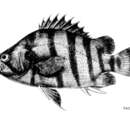en
names in breadcrumbs


Datnioides polota, commonly known as the silver tigerfish[1] or four-banded tiger perch, is a species of datnioidid fish native to brackish and fresh waters near the coast like mangrove, lagoons, estuaries and lower parts of rivers from northeastern India, through Bangladesh and mainland southeast Asia, to Sumatra and Borneo.[2][3] Although sometimes reported from New Guinea, this population is now recognized as D. campbelli.[3] D. polota is a predatory fish that reaches up to 30 cm (1 ft) in standard length.[2]
Datnioides polota, commonly known as the silver tigerfish or four-banded tiger perch, is a species of datnioidid fish native to brackish and fresh waters near the coast like mangrove, lagoons, estuaries and lower parts of rivers from northeastern India, through Bangladesh and mainland southeast Asia, to Sumatra and Borneo. Although sometimes reported from New Guinea, this population is now recognized as D. campbelli. D. polota is a predatory fish that reaches up to 30 cm (1 ft) in standard length.